8am and damn hot, 8am and bloody humid, 8am in the Brazilian
rainforest. Tramping through the jungle and trying to keep up the
fast pace of the Indian guides, the perspiration stung as it ran
into my eyes. My camera pack seemed to weigh a ton and was biting
into my 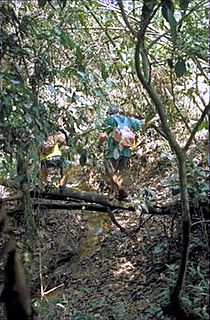 shoulders. Then we burst upon it. It was only a
small ravine, a twenty-foot drop to a rocky bottom, where, in the
wet season the tiny stream would swell into a fast flowing angry
river. The streamlet travelled between large sharp rocks and
seemed to be willing me to fall.
shoulders. Then we burst upon it. It was only a
small ravine, a twenty-foot drop to a rocky bottom, where, in the
wet season the tiny stream would swell into a fast flowing angry
river. The streamlet travelled between large sharp rocks and
seemed to be willing me to fall.
The bridge across this dangerous gap was a dripping wet tree trunk about 16 inches in diameter and 35 foot long. I had camera gear as well as my overweight body to haul across to the other side, preferably without anything too disastrous happening either to my equipment or myself! I paused and thought, “It could all end in tears before our adventure has really begun.” Adam and I had finally reached the Amazon rain forest and were following the Yawanawa guides along what, to me, seemed a non-existent trail. We brushed aside all sorts of hanging vegetation that criss-crossed in front of us.
I jammed my 'Tilley' hat hard on my head, trying to avoid the sharp Boca (that looks like bamboo but unlike the giant bamboo, has small, sharp, vicious thorns) from piercing any part of my face. The heat and humidity was making the sweat pour out of me like tiny rivers which ran all over my body, soaking me from head to toe. This trip was hard, tough and very different from anything I had imagined whilst planning my journey back in the calm of Kensington. “So isn't this what you so wanted?” I said to myself. “If you don't like it, it's too bloody late. Stop daydreaming: and cross that ravine.” When, finally and thankfully, I reached the other side, I stopped to take a breather – and said to myself, “Are you sure you haven't bitten off more than you can chew?”
Adam Baines and I first met in the Globetrotters Club. He had
just cycled around Vietnam and I was not long back from doing the same in New
Zealand. He had heard that I was planning a journey to somewhere
in the back of beyond of the Amazon Basin and as we both like
living on the edge, so we teamed up, thinking “what the
hell, let's do it.” Adam was thirty something, fit, and
spoke fluent Spanish; I was fifty something, not so fit and spoke
fluent Portuguese.
I was not long back from doing the same in New
Zealand. He had heard that I was planning a journey to somewhere
in the back of beyond of the Amazon Basin and as we both like
living on the edge, so we teamed up, thinking “what the
hell, let's do it.” Adam was thirty something, fit, and
spoke fluent Spanish; I was fifty something, not so fit and spoke
fluent Portuguese.
This was not only the story of a tribe's phoenix like renaissance, but was also the tale of two independent travellers' great adventure way down the Rio Gregoria near the borders of Brazil and Peru. 'Yawanawa' – 21st Century Warriors' was a taste of where we've been, what we have done and what's been done to us, what we enjoyed what we didn't, did it all turned out cool or did it all end up pear shaped? Like the films used to say – it all started back in the summer, when – – –
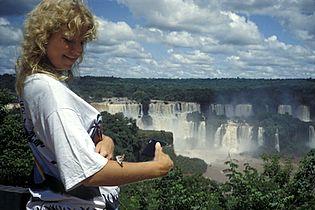 So Adam and I went off
into the depths of the green rainforest and our story of
frustrations and successes have been written down and seen in
various articles, slide shows, for the Globetrotters Club and
others. To this day we are still good friends having survived the
'Urban Jungle' as well as the 'Amazon jungle'.
So Adam and I went off
into the depths of the green rainforest and our story of
frustrations and successes have been written down and seen in
various articles, slide shows, for the Globetrotters Club and
others. To this day we are still good friends having survived the
'Urban Jungle' as well as the 'Amazon jungle'.
A lovely lady had introduced me to the GT Club around seventeen years ago and awakened my interest not only in her lovely self but also to adventure travel around the world. We saw where the Amazon met the sea in Marajo in the north and travelled south to those magnificent falls at Foz do Iquacu as well venturing into Africa. A wonderful adventurous person, the type one could only encounter at our club.
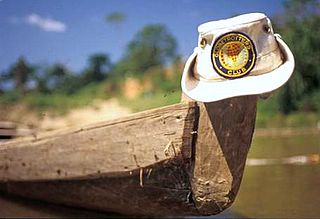 I have met and I'm sure I will still meet
some wonderful and life long friends in my time at the
Globetrotters Club. So thanks to them, some good nights in the
pub with Dick and with the members – Good conversation after the
'Slide Talks' have finished – My independent travelling
days are not yet over, with the help of all my vitamins, I will
continue to roll around this exciting world, either with or
without a travelling companion from our great Globetrotters Club.
I have met and I'm sure I will still meet
some wonderful and life long friends in my time at the
Globetrotters Club. So thanks to them, some good nights in the
pub with Dick and with the members – Good conversation after the
'Slide Talks' have finished – My independent travelling
days are not yet over, with the help of all my vitamins, I will
continue to roll around this exciting world, either with or
without a travelling companion from our great Globetrotters Club.
About the author Tony Annis: Have camera will travel. Over the top but not yet over the hill. Past sixty five and still alive, my get up and go has not entirely got up and gone – like good whisky, I'm still going strong. Travelling through these global villages of ours is great adventure but to me it is the people that make this wonderful world, as well as the exotic places that I love to visit. See you over the next horizon, Tony.

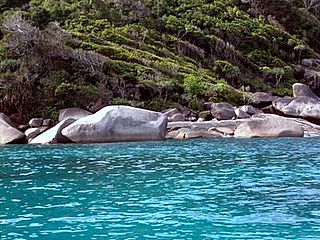 The Similan Islands can be found about one hundred kilometres northwest of Phuket, Thailand. They comprise nine granite islands covered in tropical jungle. The word Similan is said to be given by Malay fisherman who named it “The Nine Islands” (Sembilan is “nine” in Malay) and now the islands are identified by a Thai name and a number, for example, Ko Huyong (Island #1), located at the southern end of the chain or Ko Miang (Island #4) located in the middle. The Similan Islands are national parks and there is limited accommodation on them.
The Similan Islands can be found about one hundred kilometres northwest of Phuket, Thailand. They comprise nine granite islands covered in tropical jungle. The word Similan is said to be given by Malay fisherman who named it “The Nine Islands” (Sembilan is “nine” in Malay) and now the islands are identified by a Thai name and a number, for example, Ko Huyong (Island #1), located at the southern end of the chain or Ko Miang (Island #4) located in the middle. The Similan Islands are national parks and there is limited accommodation on them.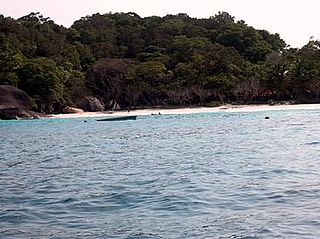
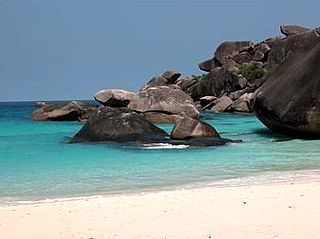 There were 15 of us and three dive guides. Usually, you are put into groups according to experience, but this did not happen here, so we had mixed ability groups, and then I discovered that of the 15 people, 5 people were novices and had only just completed their PADI open water course, which seemed incredibly mean for them – the Similans is not easy diving, strong currents and deep. The problem with being in mixed groups is that in these conditions, you usually have to surface when the first person is low on air and needs to come up to the surface, and in this case, this was sometimes after 20 minutes. Not ideal. Having said this, the beginner divers coped extremely well with the difficult conditions, far better than I would have at their level. It wasn’t their fault, they’d just been ill advised to go to the Similan Islands. There was one couple who didn’t mix much with the rest of the group, who between them had a couple of hundred dives. It seemed to be their mission to destroy as much sea life as possible on each and every dive. Between them, they seemed to flatten and break any hard corals that came in their way. Night dives were the worst times to witness this mass destruction. The dive guides said and did nothing about this blatant lack of consideration, and bad dive manners. None of us wanted to dive with them, and after a while they were allowed to go off and do their own thing as they were also avid photographers and were usually far behind the rest of the group anyway.
There were 15 of us and three dive guides. Usually, you are put into groups according to experience, but this did not happen here, so we had mixed ability groups, and then I discovered that of the 15 people, 5 people were novices and had only just completed their PADI open water course, which seemed incredibly mean for them – the Similans is not easy diving, strong currents and deep. The problem with being in mixed groups is that in these conditions, you usually have to surface when the first person is low on air and needs to come up to the surface, and in this case, this was sometimes after 20 minutes. Not ideal. Having said this, the beginner divers coped extremely well with the difficult conditions, far better than I would have at their level. It wasn’t their fault, they’d just been ill advised to go to the Similan Islands. There was one couple who didn’t mix much with the rest of the group, who between them had a couple of hundred dives. It seemed to be their mission to destroy as much sea life as possible on each and every dive. Between them, they seemed to flatten and break any hard corals that came in their way. Night dives were the worst times to witness this mass destruction. The dive guides said and did nothing about this blatant lack of consideration, and bad dive manners. None of us wanted to dive with them, and after a while they were allowed to go off and do their own thing as they were also avid photographers and were usually far behind the rest of the group anyway. 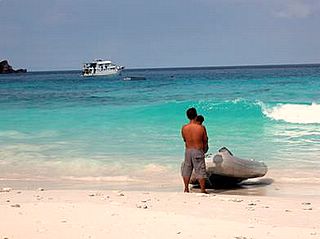
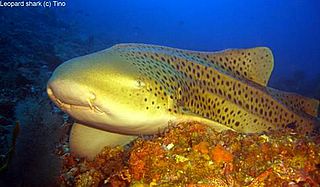 Strong currents in places, a lot of surge in others, and in one case, 3m visibility. I’d done a couple of dives around the Phi Phi islands on a cattle boat (i.e. 45 divers), which whilst the visibility was not that great, the diving was far superior to all but two of the dives I did on the Similan Islands. Something was wrong, seriously wrong, it should not have been like this.
Strong currents in places, a lot of surge in others, and in one case, 3m visibility. I’d done a couple of dives around the Phi Phi islands on a cattle boat (i.e. 45 divers), which whilst the visibility was not that great, the diving was far superior to all but two of the dives I did on the Similan Islands. Something was wrong, seriously wrong, it should not have been like this.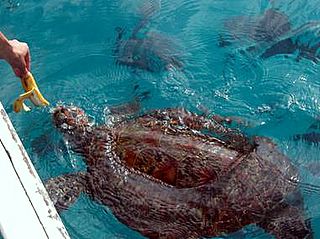 really happened. It seems to be like this: the owner of the boat is greedy, he pays the crew including the dive masters very little, but is good at marketing. The three dive masters had never worked together before and were relatively new to the Similans and one is well known for not looking after their charges. Theï¿Â½dive sites we visited were largely not the best for diving, but more convenient for the sailing schedule. I am not pleased that given the money I paid that we didn’t even tick off some of the best sites, we just didn’t. A classic flog it and ignore the complaints scenario.
really happened. It seems to be like this: the owner of the boat is greedy, he pays the crew including the dive masters very little, but is good at marketing. The three dive masters had never worked together before and were relatively new to the Similans and one is well known for not looking after their charges. Theï¿Â½dive sites we visited were largely not the best for diving, but more convenient for the sailing schedule. I am not pleased that given the money I paid that we didn’t even tick off some of the best sites, we just didn’t. A classic flog it and ignore the complaints scenario. Mac has not been very well, but is still e-mailing strong. In this edition of the Globetrotter e-newsletter, Mac sympathises with the Beetle for being given a hard time in Sydney and talks about some of his time in Japan whilst based there shortly after WW2.
Mac has not been very well, but is still e-mailing strong. In this edition of the Globetrotter e-newsletter, Mac sympathises with the Beetle for being given a hard time in Sydney and talks about some of his time in Japan whilst based there shortly after WW2. During the interval, as well as the usual mutual aid session, club President and media personality Janet Street-Porter said a few words before blowing out the candles on a brightly coloured birthday cake. Janet, a keen walker herself, had clearly enjoyed Terry Richardson’s talk on the St. Paul Trail (see December meeting news), and is always keen to get off the well beaten track. She also made it clear that she was proud to be President of the club, and congratulated it heartily on reaching 60 years.
During the interval, as well as the usual mutual aid session, club President and media personality Janet Street-Porter said a few words before blowing out the candles on a brightly coloured birthday cake. Janet, a keen walker herself, had clearly enjoyed Terry Richardson’s talk on the St. Paul Trail (see December meeting news), and is always keen to get off the well beaten track. She also made it clear that she was proud to be President of the club, and congratulated it heartily on reaching 60 years.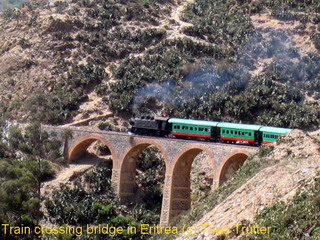 The Germans, an all male group were enthralled and clicked away with every description of cameras and also whirring away with a multitude of video cameras. Fortunately they made no objection to my discreet presence as I too clicked away.
The Germans, an all male group were enthralled and clicked away with every description of cameras and also whirring away with a multitude of video cameras. Fortunately they made no objection to my discreet presence as I too clicked away.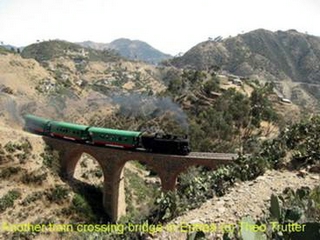 The Eritrean railway system had originally been built by the Italians during the ’20’s when they occupied Abyssinia (later renamed Ethiopia) and the meticulous stone bridges and tunnels are a lasting tribute to their artisans. Mines had also to be cleared from many places like bridges, tunnels and roadbeds.
The Eritrean railway system had originally been built by the Italians during the ’20’s when they occupied Abyssinia (later renamed Ethiopia) and the meticulous stone bridges and tunnels are a lasting tribute to their artisans. Mines had also to be cleared from many places like bridges, tunnels and roadbeds.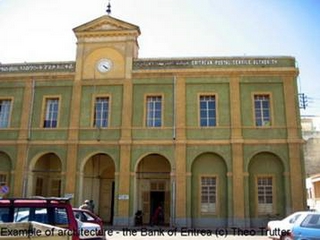 If one was lucky enough to get to the counter that day, then the wad of letters and visa application form were handed in and a suitable fee was to be paid in US $ notes-[about $150 was the usual. ] More queues – one at the cashier’s office and another queue back at the Immigration’s Visa counter, to hand over the receipt. It also was not a good idea to have to visit the toilet whilst in the queue.
If one was lucky enough to get to the counter that day, then the wad of letters and visa application form were handed in and a suitable fee was to be paid in US $ notes-[about $150 was the usual. ] More queues – one at the cashier’s office and another queue back at the Immigration’s Visa counter, to hand over the receipt. It also was not a good idea to have to visit the toilet whilst in the queue.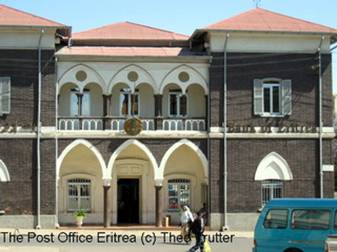 Once in possession of the Incoming Crew’s Visa, it was best to scan it, e-mail it to them so as to present it on arrival at Asmara Airport. It was possible for the Immigration department to have the visa on hand on arrival but that took a lengthy wait in yet another queue there.
Once in possession of the Incoming Crew’s Visa, it was best to scan it, e-mail it to them so as to present it on arrival at Asmara Airport. It was possible for the Immigration department to have the visa on hand on arrival but that took a lengthy wait in yet another queue there. Yet another method of visa acquisition was possible; by applying at the Eritrean Embassy. In our case this was in Pretoria but it took a week and cost plenty more than when obtained in Eritrea.
Yet another method of visa acquisition was possible; by applying at the Eritrean Embassy. In our case this was in Pretoria but it took a week and cost plenty more than when obtained in Eritrea. from
the same plane look me up and down and give me a wide berth.
Did I have
alcohol, cigarettes, perfume, or anything else over the limit or
anything else that I should have declared?
from
the same plane look me up and down and give me a wide berth.
Did I have
alcohol, cigarettes, perfume, or anything else over the limit or
anything else that I should have declared?
 Whilst
waiting for my luggage to arrive, I got talking to a lady in a
wheel chair and helped her with her luggage when I caught the same
Customs woman watching me with a beady look in her eye. I
then realised
I was in for the long run here at Sydney airport and thought back about
why she had descended on me, why she was being so rude and aggressive
and why she had picked me out. Maybe because I looked
slightly
dishevelled after the overnight flight, maybe because my passport has a
lot of stamps in it or maybe she just doesn’t like Beetles – who knows,
I will never find out.
Whilst
waiting for my luggage to arrive, I got talking to a lady in a
wheel chair and helped her with her luggage when I caught the same
Customs woman watching me with a beady look in her eye. I
then realised
I was in for the long run here at Sydney airport and thought back about
why she had descended on me, why she was being so rude and aggressive
and why she had picked me out. Maybe because I looked
slightly
dishevelled after the overnight flight, maybe because my passport has a
lot of stamps in it or maybe she just doesn’t like Beetles – who knows,
I will never find out.
 I
was instructed to open my own luggage, but not to touch anything
inside. If I hadn’t been so tired, it would have been quite
funny,
because she was so dramatic, barking orders like I’d just arrived in
prison and had to obey without question. Back pack first,
then luggage.
Item no 1 in my day pack: yummy biscuits from Singapore for the journey
I’d planned to make to the Blue Mountains. The female customs
official
tried to confiscate my chocolate chip shortbread biscuits bought in
Singapore for the long airport wait and I’d forgotten to eat them, by
claiming them to be ‘food’ – I agreed and said yes, shortbread is food,
but they are unopened and totally allowed. I asked her if she
wanted
one and she sourly said that she could not accept food because it might
be poisoned. My day dreaming got slightly the better of me,
I’d taken
the seven hour overnight flight from Singapore, had no sleep and was
far from best form but some childish notion inside me propelled me to
an alternate universe where I was watching the Customs woman writhing
on the ground having eaten a poisoned biscuit.
I
was instructed to open my own luggage, but not to touch anything
inside. If I hadn’t been so tired, it would have been quite
funny,
because she was so dramatic, barking orders like I’d just arrived in
prison and had to obey without question. Back pack first,
then luggage.
Item no 1 in my day pack: yummy biscuits from Singapore for the journey
I’d planned to make to the Blue Mountains. The female customs
official
tried to confiscate my chocolate chip shortbread biscuits bought in
Singapore for the long airport wait and I’d forgotten to eat them, by
claiming them to be ‘food’ – I agreed and said yes, shortbread is food,
but they are unopened and totally allowed. I asked her if she
wanted
one and she sourly said that she could not accept food because it might
be poisoned. My day dreaming got slightly the better of me,
I’d taken
the seven hour overnight flight from Singapore, had no sleep and was
far from best form but some childish notion inside me propelled me to
an alternate universe where I was watching the Customs woman writhing
on the ground having eaten a poisoned biscuit.
 start!
And what was so ironic about this whole episode – I was after another
30 minutes dismissed – when I got out of the airport and later picked
up a newspaper, I discovered that the whole of Australia was up in arms
about the Queensland woman who got caught smuggling 4 ½ kgs
of cannabis in her boogie board in Bali, and the suspicion that they
had been put there by a Brisbane airport based gang of airport based
dug dealer baggage handlers.
start!
And what was so ironic about this whole episode – I was after another
30 minutes dismissed – when I got out of the airport and later picked
up a newspaper, I discovered that the whole of Australia was up in arms
about the Queensland woman who got caught smuggling 4 ½ kgs
of cannabis in her boogie board in Bali, and the suspicion that they
had been put there by a Brisbane airport based gang of airport based
dug dealer baggage handlers.
 I
have been to Sydney three times before and have never been carried away
by it, and I hope that my airport experience did not colour my view,
but I came to the conclusion that the area from Liverpool st upwards to
circular quay – about half a km – is architecturally interesting, with
a mix of early 20th century buildings and modern high rise, and it too
has character. But there are some pretty hideous modern
buildings when
they could be so amazing – there are so many cities, London included,
where modern architecture, in my opinion anyway is done so
well. I
found the rest of metropolitan Sydney to be pretty dull (sorry
Australian readers!) and samey and decidedly lacking character, though
found a nice suburb, Surrey Hills, just to the right of central Station
which has lots of nice cafes and restaurants and those colonial types
of narrow terraced houses with pretty wrought iron balconies.
I also
kept being ripped off with change, this happened every single day when
I would be short changed in shops. I was also over charged by
the hotel
I stayed in in the Blue Mountains, which again didn’t feel too good; I
guess this thing happens everywhere where you are noticeably from out
of town, but this is the first time in any country this has happened to
me.
I
have been to Sydney three times before and have never been carried away
by it, and I hope that my airport experience did not colour my view,
but I came to the conclusion that the area from Liverpool st upwards to
circular quay – about half a km – is architecturally interesting, with
a mix of early 20th century buildings and modern high rise, and it too
has character. But there are some pretty hideous modern
buildings when
they could be so amazing – there are so many cities, London included,
where modern architecture, in my opinion anyway is done so
well. I
found the rest of metropolitan Sydney to be pretty dull (sorry
Australian readers!) and samey and decidedly lacking character, though
found a nice suburb, Surrey Hills, just to the right of central Station
which has lots of nice cafes and restaurants and those colonial types
of narrow terraced houses with pretty wrought iron balconies.
I also
kept being ripped off with change, this happened every single day when
I would be short changed in shops. I was also over charged by
the hotel
I stayed in in the Blue Mountains, which again didn’t feel too good; I
guess this thing happens everywhere where you are noticeably from out
of town, but this is the first time in any country this has happened to
me.
 City of Culture in 1990: virtual tour of his surviving works. Glasgow is a
City of Culture in 1990: virtual tour of his surviving works. Glasgow is a